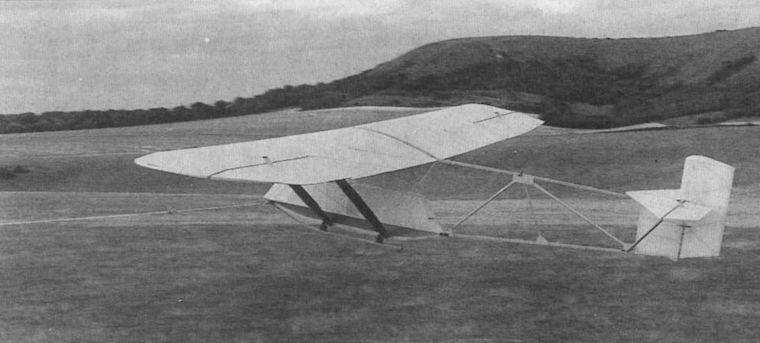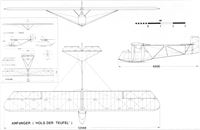
Варианты
- Lippisch / RRG - Hols der Teufel - 1923 - Германия
- Schleicher - Poppenhausen - 1928 - Германия
M.Simons The World's Vintage Sailplanes 1908-45
THE ANFAENGER (HOLS DER TEUFEL)
The first Hols der Teufel appeared in 1923 as a training glider, designed by Alexander Lippisch. It was a forerunner of the Zoegling primary trainer. “Hols der Teufel” is a German slang expression meaning, roughly, “Devil take it”. The original was built in the Weltensegler workshops. Two Swedish student pilots who were eking out their money by working for the company, became noted for their use of the mild curse, in their own language, Djaevlar Anamma, whilst building the aircraft, and when it flew the phrase was almost automatically attached to it. The German translation was Hols der Teufel. The 1923 version had a rectangular wing planform with square tips, of 10.5 metres span. The Zoegling, later, had almost the same wing. The fuselage was an open framework but the pilot was enclosed by a light, fabric-covered nacelle. In front of his head was a strut which ran from the extreme nose up to the kingpost above the wing. This was the origin of the so-called 'skullsplitter’ ( Schadelspalter) which appeared on Edmund Schneider's primary gliders but was not retained on the Zoegling by Lippisch. The tailplane of the Hols der Teufel was large, giving it plenty of stability in pitch. The skid for landing was unsprung. The wing and tail were wire braced. Alexander Schleicher, now beginning to establish his factory at Poppenhausen, flew his own Djaevlar Anamma at the competitions in 1927.
In 1928 Hans Jacobs, working under Lippisch at the Wasserkuppe design office of the RRG, published a small book explaining how to build and repair gliders. In a folder in the back of this small volume was a set of plans, on three sheets, for a glider, the Anfaenger (Beginner), which resembled the old Hols der Teufel type. It was a completely new design. The wing was of 12.5 metres span with rounded tips, the rear fuselage an open 'gate' frame but the nacelle had no 'skullsplitter’ strut and was partly plywood covered. The wings, instead of being wire braced, were supported by two parallel struts on each side. The Jacobs design was particularly suitable for first attempts at soaring in light winds over slopes. At about the same time, other types of similar general layout and with similar purpose, appeared, the Hangwind for example, and in Poland, Czerwinski's CJT-2.
Jacobs’ book sold quite well and a good many clubs in Germany and other countries set about building to his plans. Schleichers also built some for sale, reverting to the name, Hols der Teufel, and some of these were exported complete or in kit form, to England. Others went to various countries in Europe.
Technical data:
Lippisch Hols der Teufel: Span, 10.50 m. Wing area, 16.8 sq m. Aspect ratio 6.56.
Schleicher/Jacobs Hols der Teufel: Span, 12.568 m. Wing area, 19.52 sq m. Aspect ratio 8.1.
- M.Simons The World's Vintage Sailplanes 1908-45
Фотографии
-
Aeroplane Monthly 1991-09 / M.Challinor - 60 years of Ups on the Downs
Lift-off! Historic Sailplane Group founder Mike Beach’s superb Hols der Teufel takes off from Dunstable last year in the first Hols launch from the site for more than 50yr, and possibly the first ever winch launch of the type.
-
Flight 1931-10 / Flight
A beginner's soarer, the Hols der Teufel with a member of the London Gliding Club just taking off. Herr Hirth soared in this machine during the meeting. This machine was designed in 1923 by Herr Lippisch, the designer of Herr Kronfeld's "Wien."
-
GL / M.Simons - The World's Vintage Sailplanes 1908-45 /Kookaburra/
A Hols der Teufel, built in England in 1931.
-
Flight 1931-05 / Flight
A view down the gallery at the Agricultural Hall. The gliders from left to right are the Hols-der-Teufel, the Scud, the Albatross, and the B.A.C. VI. Between this last and the Albatross is one of the Rice folding caravans.
Другие самолёты на фотографии: Abbott-Baynes Scud - Великобритания - 1931Latimer-Needham Albatross - Великобритания - 1930Lowe-Wylde Columbus / BAC.II - BAC.IX - Великобритания - 1930
-
Aeroplane Monthly 1990-10 / M.Oakey - Grapevine
Mike Beach in his newly-completed 1928-designed Hols der Teufel glider at Dunstable in mid-August 1990, where it made its first test flights. "I don't call it a replica ”, says Beach, "as the plans were sold for amateur construction - so it s just rather late in arriving!” With Beach are (left) Dan Smith, a founder-member of Dunstable's London Gliding Club and the last man to fly a Hols there, in the mid-Thirties, and (right) Geoffrey Stephenson, who was the first to soar a glider from England to France in 1939. The Hols will he at the Historic Sailplane Group's meeting at Dunstable on September 21-24.
-
GL / M.Simons - The World's Vintage Sailplanes 1908-45 /Kookaburra/
As soaring sailplanes developed, new training methods evolved. Two-seaters like the Margarete were expensive and the training school on the Wasserkuppe, founded by Arthur Martens, used solo training methods. The first solo primary trainer was the Hols der Teufel designed by Alexander Lippisch in 1923. This was strengthened and simplified to produce the Pegasus, shown here. The pupil was taught to fly by being given a long series of gentle slides and low hops, gradually increasing until he could manage a straight glide of 30 seconds to earn his ‘A' gliding badge. The ‘B' certificate required him to perform turns. Bungee launching was used, much depending on the judgment of the instructor as to the force of the launch to be given at each stage.
-
GL / M.Simons - The World's Vintage Sailplanes 1908-45 /Kookaburra/
From the Pegasus, Gottlob Espenlaub and Edmund Schneider developed their own primary trainers. It was at Grunau that Wolf Hirth set up his early training school. He used the Schneider trainers which were improved year by year to arrive at the ESG-9 (Edmund Schneider, Grunau, Type 9), which is shown here. Like the Hols der Teufel and Pegasus, the Grunau 9 had a front strut ahead of the pilot. The wing and tail unit were almost identical to the original Hols der Teufel. Flying speeds were very low and although the front strut was called the Schadelspalter (skullsplitter), such injuries were unknown.
-
Aeroplane Monthly 1993-06 / M.Oakey - Grapevine
A line-up of rarities at Brooklands. From the foreground: Slingsby Falcon I replica; Slingsby Gull III; Schleicher Rheinland; Manuel Willow Wren BGA 162; Abbott-Baynes Scud II; Hols der Teufel replica; Bleriot XI G-LOTI.
Другие самолёты на фотографии: Abbott-Baynes Scud - Великобритания - 1931Bleriot Bleriot-XI - Франция - 1909FVA (Flugwissenschaftliche Vereinigung Aachen) FVA-10 Rheinland - Германия - 1936Lippisch / RRG Falke - Германия - 1930Manuel Wren - Великобритания - 1931Slingsby T.12 / T.14 / T.15 Gull - Великобритания - 1938
-
Aeroplane Monthly 1996-07 / 1996 UK Aircraft Collections and Museums Guide (1)
A special exhibition of Mike Beach’s glider collection (plus his Bleriot XI at top left) at the Brooklands Museum in 1993. From bottom of picture: Slingsby Falcon I replica, Slingsby Gull 3, Schleicher Rheinland, Manuel Willow Wren, Abbott-Baynes Scud II, Hols der Teufel replica. All but the Rheinland are still at Brooklands, although space limitations dictate that they spend much of their time stored in their trailers. The hangar in this view has since been demolished.
Другие самолёты на фотографии: Abbott-Baynes Scud - Великобритания - 1931Bleriot Bleriot-XI - Франция - 1909FVA (Flugwissenschaftliche Vereinigung Aachen) FVA-10 Rheinland - Германия - 1936Lippisch / RRG Falke - Германия - 1930Manuel Wren - Великобритания - 1931Slingsby T.12 / T.14 / T.15 Gull - Великобритания - 1938
-
GL / M.Simons - The World's Vintage Sailplanes 1908-45 /Kookaburra/
Anfanger ('Hols der Teufel')
- Фотографии









